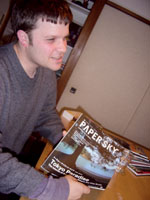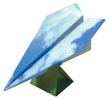Voice: From Tokyo to the World
Back to Contents of Issue: May 2004
|
|
|
|
by Roland Kelts |
|
|
Given the stats it's hard to find (or imagine) anyone feeling safe, let alone sanguine, in Tokyo's English-language media scene. But a magazine launched quietly two years ago in the warren of Shibuya alleyways is defying the trend with considerable elan.
Instead of folding and trekking to Beijing (or retreating to New York or London), the bilingual Paper Sky is not only thriving here in Japan (with an estimated readership of 50,000) -- it's now going global.
Paper Sky, whose tagline is "a new way to travel," is the brainchild of 33-year-old publisher Lucas Badtke-Berkow, a Californian who came to Japan straight out of UC Santa Cruz 13 years ago with little else but a vague wanderlust and a keen interest in Japanese design. "Commes des garons, Yoji Yamamoto and Issey Miyake -- they were just getting big back then," he says. "And the magazines from Japan were so unique."
Badtke-Berkow made his contacts as a freelancer. By 1996, he was ready to found his own company: Knee High Media Japan (KHMJ). The unassuming moniker seems intentional: Badtke- Berkow is soft-spoken and unpretentious -- as if he'd just stumbled upon his apparent success.
KHMJ launched its first title, Tokion, in 1996. "The kanji were for toki, or 'time,' and on, or 'sound.' So it was supposed to be 'the sound of now.' It was a youth culture magazine." After a strikingly successful run, during which the magazine was released in the US a year after its birth, Badtke-Berkow sold the rights to a publisher in New York, where it is still being produced.
"Basically, I outgrew [Tokion]. There was a boom. Anyone in Harajuku could do anything with a T-shirt. But I think that's waning now."
By now into his 30s, Badtke-Berkow teamed up with fresh talent: Texan writer and editor Peter Wilson (who now heads the international publishing branch, Lite House Media), Japanese editor Kosuke Idee, and his younger brother, Joseph. Together they conjured the concept behind what would become Paper Sky: a sophisticated in-flight magazine produced and consumed on the ground. A traveler's guide, but not to the sites and hotel bargains. The magazine "captures our place in time, which, at the start of the 21st century, happens to be everywhere," says brother Joseph, who landed in Tokyo from Europe after a stint with National Public Radio in the US.
When I cite the line, both Badtke-Berkow brothers nod appreciatively. And from his offices in New York, KHMJ partner Lite House Media's Wilson qualifies the statement: "Paper Sky is about what you would find if you peeled back a layer of culture and immersed yourself in it."
Wilson is presiding over the US launch on April 14, when the bilingual Paper Sky will suddenly appear in Barnes & Noble and Borders bookshops across the US, with special concentration on New York, Los Angeles and San Francisco, courtesy of Ingram, one of America's more aggressive distributors. An initial ciruculation of 20,000 copies plus extensive sampling (free issues) will get the word out, and a classic Manhattan publishing party will take place at the end of April. Thereafter, both publishers are looking to the European market, with the possible opening of a London or Paris office in 2005.
This all sounds seductively romantic. But the challenges of selling such a unique concept are obvious.
In order to keep this passion afloat, Lucas has diversified in the most unorthodox fashions -- literally. "Fashion and travel are what's behind Paper Sky," he notes.
KHMJ operates two subsidiaries in Japan: Grande Creative, a design firm that has produced exquisite bilingual catalogs for brands as diverse as Lego and Birkenstock. And Mammoth, a kids-oriented division that publishes Mammoth magazine -- ostensibly for kids by kids, though, as Lucas explains, "it's pretty much for moms." Mammoth magazine is a romper room of color and cartoons, and comes as a package boxed with toys, often designed by clients. Mammoth recently tied up with SHIPS, the hip Japanese family-oriented clothing corporation, to jointly produce children's clothing.
Bridging the gap between magazine publishing and catalog design is nothing new. But ... children's clothing?
"Paper Sky's too adult," Lucas says, smiling. "We wanted to do something fun as well."
But it's hard not to see something blossoming -- and built to last longer than the cherry buds of a Japanese spring. With only eight full-time staff members (plus legions of outsourced talent), KHMJ is producing a flagship magazine in the world's two most media-saturated nations, a children's book and clothing line, a catalog division -- and by May 15, a Paper Sky-produced bookshop and cafe in one Tokyo's tony Aoyama neighborhood.
The shop is called "Book 246," named after the busy thoroughfare that courses past its entrance. The result of another partnership, this time with Community & Stores, Inc., owners of fashionable bars and cafes throughout Japan, the travel-oriented shop will feature live events, travel-related paraphernalia and books arranged according to regions of the globe: Asia, the Middle East, Europe and so on. It's a local outlet for KHMJ and Paper Sky's global visions.
Still, the brothers are coolly reflective when I suggest that they might be breaking new ground with their efforts.
"It would probably be better if we had some competition," Lucas muses. "But we're really alone out here. There's no one like us."
@
|
|
Note: The function "email this page" is currently not supported for this page.


 "Right now, it's a holocaust for English-language publications in Japan," says David McNeill, reporter for the Independent of London and a professor at Tokyo's Sophia University. Last fall, McNeill wrote a devastating assessment of the English-language media exodus, citing six major publications that had drastically cut their staffs in Japan or folded up completely.
"Right now, it's a holocaust for English-language publications in Japan," says David McNeill, reporter for the Independent of London and a professor at Tokyo's Sophia University. Last fall, McNeill wrote a devastating assessment of the English-language media exodus, citing six major publications that had drastically cut their staffs in Japan or folded up completely.
 "There was all this great stuff here, and artists and designers and ideas," he says. "And yet everything was still coming into Japan from around the world. And I thought: 'Why isn't anything going the other way -- from Japan to the rest of the world?'"
"There was all this great stuff here, and artists and designers and ideas," he says. "And yet everything was still coming into Japan from around the world. And I thought: 'Why isn't anything going the other way -- from Japan to the rest of the world?'"
 The concept is most succinctly expressed in the works of Pico Iyer, who happens to have been interviewed in an early issue of Paper Sky, and happens to live and write -- when he's not in the air -- in bucolic Nara, Japan. In Iyer's 2000 book, The Global Soul, he describes a new breed of global "full-time citizens of nowhere."
The concept is most succinctly expressed in the works of Pico Iyer, who happens to have been interviewed in an early issue of Paper Sky, and happens to live and write -- when he's not in the air -- in bucolic Nara, Japan. In Iyer's 2000 book, The Global Soul, he describes a new breed of global "full-time citizens of nowhere."
 "A lot of advertisers don't get us right away," Wilson admits. "'Is this for a Japanese reader?'" they say. And I tell them, 'No, it's for a Japanese, American and European reader. This is a new kind of media which transcends the simple market initiative of a set demographic. We seek out like-minded readers on three different continents.'"
"A lot of advertisers don't get us right away," Wilson admits. "'Is this for a Japanese reader?'" they say. And I tell them, 'No, it's for a Japanese, American and European reader. This is a new kind of media which transcends the simple market initiative of a set demographic. We seek out like-minded readers on three different continents.'"
 In the giddy late-90s, this was optimistically called synergy, and seemed to reach its apogee with the ballyhooed Talk/Miramax tie-up that eventually fizzled. But KHMJ is operating with a more humble, and some might say shrewder, set of principles. When I dare to suggest that the company is becoming a "mini media-empire," the publisher laughs openly. "We're still looking for the 'empire' part."
In the giddy late-90s, this was optimistically called synergy, and seemed to reach its apogee with the ballyhooed Talk/Miramax tie-up that eventually fizzled. But KHMJ is operating with a more humble, and some might say shrewder, set of principles. When I dare to suggest that the company is becoming a "mini media-empire," the publisher laughs openly. "We're still looking for the 'empire' part."



